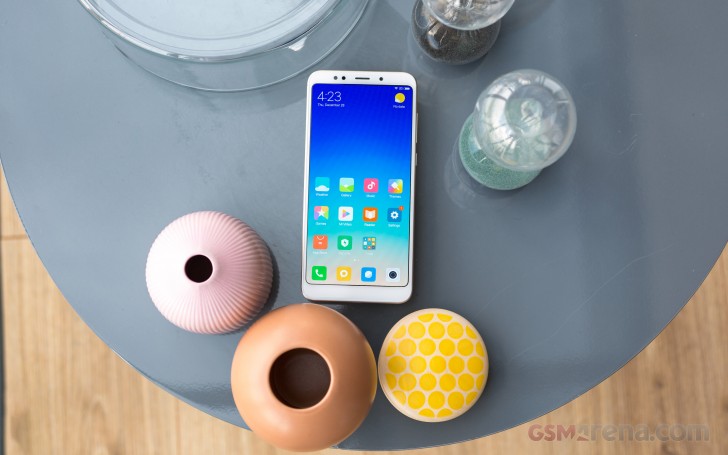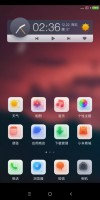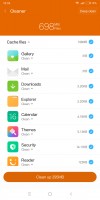Introduction
So, no more Redmi Notes eh? The Redmi 5 Plus should clearly have been the Note 5, a successor of the Redmi Note 4, but Xiaomi wanted a fresh start. The fifth generation is trying to shake things up and the new look obviously called for a new name. So, Xiaomi retired the Note brand promoting the Plus from a mere qualifier to a proper name. The phablet lives on regardless, and goes all-in with a wide 6" screen.
'Tis the season of tall screens and Xiaomi is the next maker to go 18:9 in the midrange as well. Both the Redmi 5 and Redmi 5 Plus have wide screens and both build on the predecessor's 5.5" diagonal with 5.7" and 5.99" respectively.

The Redmi 5 Plus may have received a pretty obvious upgrade, but that's nearly all that's new. The 5 Plus keeps the Snapdragon 625 chip and 4,000mAh battery of the Redmi Note 4. The old 5MP selfie camera stays too, while the rear cam now has bigger pixels but smaller aperture.
Xiaomi Redmi 5 Plus specs:
- Body: Metal unibody, 2.5D glass front
- Screen: 5.99" IPS LCD, 1080p (403ppi); Gorilla Glass (undisclosed version)
- Chipset: Snapdragon 625, 8x Cortex-A53@2.0GHz, Adreno 506
- Memory: 3/4GB RAM + 32/64GB storage, Hybrid microSD slot
- Camera: 12MP, f/2.2, PDAF, 1080p video @ 30fps
- Selfie cam: 5 MP, 1080p video @ 30fps
- OS: Android 7.1.2 Nougat, MIUI 9 on top
- Battery: 4,000mAh (non-removable)
- Connectivity: Hybrid Dual Nano-SIM (hybrid microSD slot); LTE Cat4 150/50 Mbps support; Wi-Fi g/b/n; Bluetooth 4.1; GPS with GLONASS; FM radio; 3.5mm audio jack; microUSB port
- Misc: Fingerprint reader
We always get excited when a new Redmi checks in and enjoy watching Xiaomi give the competition a good run for its money. By the looks of the new Redmi 5 series, Xiaomi is keen on doing it again.
Xiaomi Redmi 5 Plus Unboxing
The Redmi 5 Plus comes wrapped in an all-red cardboard box. Just as nearly every single Redmi before it, the 5 Plus is bundled with a 10W charger (5V/2A) and a microUSB cable. Xiaomi also provides a transparent rubber case, but we almost missed it as it was packed with the quick start guides, which no one cares about, right?

Design
It seems Xiaomi didn't make itself quite a favor last year with the Helio-powered Redmi Note 4. An all-metal unibody and diamond-cut antenna ducts looked cool. Maybe even too cool for the global Snapdragon-powered version, which felt almost like a downgrade when it was released. Both of them pretty much reused the Redmi Note 3 design and that wasn't such a bad thing back then. However, recycling it yet again for the Redmi 5 Plus is too much perhaps.
Here is an all-around view of the Redmi 5 Plus.Perhaps, Xiaomi didn't go for a complete re-design because the widescreen gave it enough of a new look and feel. Below the noticeably bigger screen, the capacitive keys are gone for good. The subtle 2.5D effect on the front glass is still there but not too prominent.
Flip the Redmi 5 Plus and you'll find a virtually identical back with the Redmi Note 4. The top and bottom antenna inlays are made of plastic, while the centerpiece is all metal as is the camera rim. If it weren't for the difference is size, the Note 4 and 5 Plus would have been impossible to tell apart.

Now take a look at the Redmi Note 4. The Redmi 5 Plus is 7mm taller than the Redmi Note 4 and weighs 180g (15g heavier).

The good news is it's really hard to tell the plastic bits of the Redmi 5 Plus, but Xiaomi could have done a better job at matching the paint with the rest of the body.
There are no surprises on the Redmi 5 Plus, new screen or not. The hybrid card slot lets you choose between a second SIM or a microSD, while the top of the 5 Plus has the good ol' audio jack and the fan-favorite IR blaster.
Over at the bottom, the single speaker and the primary mic are behind symmetrical micro-drilled grilles.

Display
Xiaomi has equipped the Redmi 5 Plus with a trending 6" display of 1,080 x 2,160px resolution. The Redmis are the next midrange series to adopt the 18:9 wide aspect ratio. The tall screen is the single most important change on the 5 Plus feature list, so let's see if it really make for a solid upgrade.
Stretching the 1080p resolution across a 6" display doesn't hurt the Redmi 5 Plus, which still keeps a respectable 403ppi. We enjoyed sharp images and no pixelization whatsoever.

Xiaomi promises 1000:1 contrast and a maximum brightness of 450 nits. In our tests it surpassed both promises with a maximum brightness north of 500 nits and an excellent contrast at 1431:1. The black levels are quote deep too.
When we set the brightness at auto, the screen went as high as 555 nits at the expense of some contrast.
| Display test | 100% brightness | ||
| Black, cd/m2 | White, cd/m2 | ||
| 0.355 | 508 | 1431 | |
| 0.548 | 555 | 1013 | |
| 0.322 | 484 | 1503 | |
| 0.42 | 403 | 953 | |
| 0.289 | 515 | 1782 | |
| 0.192 | 422 | 2198 | |
| 0.214 | 462 | 2159 | |
| 0.288 | 510 | 1771 | |
| 0.257 | 476 | 1852 | |
| 0.351 | 551 | 1570 | |
The sunlight legibility is not among the best we've seen, but it's a reasonably good score for the price bracket. If you don't mind some washed-out colors and loss of contrast the screen should remain readable when you're out and about on a bright sunny day.
MIUI 9 and Android Nougat
The Redmi 5 Plus runs on Xiaomi's own MIUI 9 - a neat launcher based on the latest Android Nougat version - 7.1.2. While MIUI is one of the most popular launchers with great support, it's been somewhat behind the competition when it comes to the latest Android adoption.
MIUI has been known for its clean interface, but looks are deceiving as it also offers a ton of customization options and advanced system tools at your disposal if you dig in.

MIUI 9 builds on v. 8 with multi-window support, quick replies for notifications, smart app launcher, smart assistance, and smart image search. Yes, there is a lot of "smart" with MIUI 9 and it's possible thanks to the new machine learning process. There are tons of improvements under the hood, too, such as better RAM management, faster performance, lighter on resources, and improved doze mode.
The novelties aside, it's MIUI however you look at it - every shortcut, plus widgets of your choosing, are dropped on the homescreen. You get a docked menu for the most commonly used apps, of course. The notification drawer comes from the top and has the quick toggles, as usual.
There is a Quick Card pane, the leftmost one. It's quite similar to Today's page in iOS. It contains different cards with relevant information - recent apps, step counter, notes, calendar events, the weather, and favorites, among others. You can configure what shows up here, or you can disable this altogether.
The app switcher feels like it came out of iOS - apps are represented by appropriate thumbnails in the same manner, but there is an additional key for the Split Screen mode. MIUI 9 adds native support for multi-tasking via the new Split Screen feature. It allows you to launch two apps side-by-side. All native apps support it and, luckily, all third-party apps with support for any kind of split screen mode work flawlessly on MIUI 9 side-by-side view.
Themes are fully supported, and several are available out of the box. You can download more and change your wallpapers, lockscreen style, system icons, font, and sounds.
MIUI v9 also offers a Security app. It can scan your phone for malware, manage your blacklist, manage or restrict your data usage, configure battery behavior, and free up some RAM. It can also manage the permissions of your installed apps, and allows you to define the battery behavior of selected apps and applies restrictions only to the apps you choose.
MIUI also offers proprietary Gallery, Music, and Video player. If you are running on a Chinese ROM, then the Music and Video app will also allow access to local (paid) streaming services.
Benchmarks and performance
Xiaomi Redmi 5 Plus is powered by the Snapdragon 625 SoC - the same in charge of the Redmi Note 4. Other companies have already switched to the Snapdragon 630 with newer and more powerful GPU, but Xiaomi is sticking to the previous generation for some reason.

The Snapdragon 625 is pretty familiar as it was the most popular SoC for mid-rangers throughout 2017. It has an octa-core Cortex-A53 processor and Adreno 506 graphics. Just like the Redmi Note 4, the 5 Plus may come with either 3 or 4 GB of RAM, depending on the integrated storage (32 or 64 GB).
As usual, we ran Geekbench to see how the 8xA53 processor does. Not that we didn't already knew by the whole bunch of phones we've tested to date. And the Redmi 5 Plus didn't bring any surprises, for better or worse. Its processor is as fast and as capable as the rest of the competition.




























EmoticonEmoticon